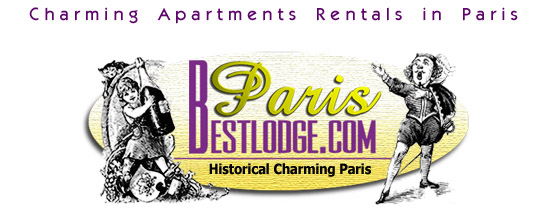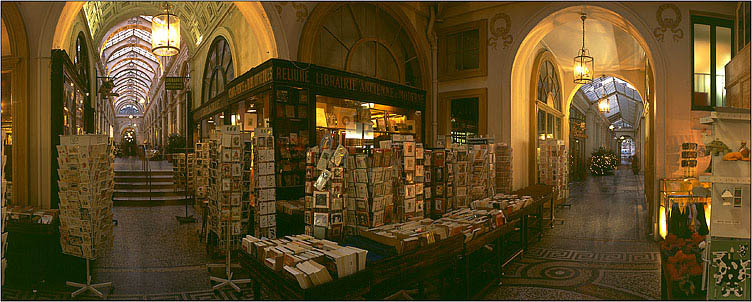
Les
Passages couverts de Paris

Passage Vivienne
Designed by town planners in the nineteenth century to give
pedestrians protection from mud and horse-drawn vehicles, the passages
(shopping arcades), between the Grands Boulevards and the Louvre, are
enjoying a new lease of life as havens from today's far busier traffic.
For decades they were left to crumble and decay, but many have now been
renovated, their tiled floors and glass roofs restored. Their
entrances, however, remain easy to miss, and where you emerge at the
other end can be quite a surprise, many are closed at night and
on Sundays.
Galerie Véro-Dodat
Between rue Croix-des-Petits-Champs and rue
Jean-Jacques Rousseau, Galerie Véro-Dodat is the most
homogeneous and aristocratic od the passages, with painted ceiling a nd
panelled shop fronts divided by black marble columns. It's named after
the two pork butchers who set it up in 1824. Although the galerie is a
little dilapidated, with peeling paint on many of the shop fronts,
fashionable new shops have begun to open up in place of the older
business. Retaining the old style at n° 26, monsieur Capia still
keeps a collection of antique dolls in a ship piled high with
miscellaneous curios.
Galerie
Colbert and Vivienne (Photographies)
The beautifully Galerie Colbert, one of two very
upmarket passages linking rue Vivienne with rue des Petits-Champs,
contains an expensive 1830s-style brasserie, le Grand Colbert, to which
senior librarians and rich academics from the nearby Richelieu site of
the Bibliothèque Nationale retire for lunch. The flamboyant
decor of Grecian and marine motifs in the larger Galerie Vivienne,
establishes the perfect ambiance in which to buy Jean-Paul Gaultier
gear, or you can browse in the antiquarian bookshop, Librairie
Jousseaume, which dates back to the passages's earliest days.
Passage Choiseul
Three blocks west of the Bibliothèque Nationale is a totally
different style of passage. Just like a regular high street, the
passage Choiseul, between rue des Petits-Champs and rue St-Augustin,
has takeaway food, cheap clothes shop, stationers and bars, plus a few
arty outlets along its two-hundred-metre tiled length. It was here that
the author Louis-Ferdinand Céline lived as a boy, a period and
location vividly recounted in his novel Death on Credit.
Passage des Panoramas
For a combination of old-fashioned chic and workaday
you need to explore the passage des Panoramas, the grid of arcades
north of the Bibliothèque Nationale, beyond rue St-Marc, though
they're still in need of a little repair and don't have the fancy
mosaics of the other arcades. Most of the eateries here make no
pretence at style, but one old brasserie, l'Arbre à Cannelle,
has fantastic carved wood panelling, and there are still bric-a-brac
shops, stamp dealers and an upper-crust print shop with its original
1867 fittings. It was around the Panoramas, in 1817, that's the first
parisian gas lamps were tried out.
Passage Jouffroy and Verdeau
In passage Jouffroy, across boulevard Montmartre, a
M. Segas sells walking canes and theatrical antiques opposite a shop
displaying every conceivable fitting and furnishing for doll's houses.
Near the romantic Hotel Chopin, Paul Vulin sets out his secondhand
books along the passageway, and Ciné-Doc caters to cinephiles.
Crossing rue de la Grange-Batelière, you enter passage Verdeau,
where a few of the old postcard and camera dealers still trade
alongside new art galleries and a designer italian delicatessen.
Passage des Princes
At the top of rue de Richelieu, the tiny Passage des
Princes, with its beautiful glass ceiling, stained-glass decoration,
and twirly lamps, has finally been restored, but unfortunately lies
empty - high rents have chased out the shops that were here. Its
ertswhile neighbour, the passage de l'Opéra, described in
surreal detail by Louis Aragon in Paris peasant, was eaten up
with the completion of Haussmann's boulevards - a project that
demolished scores of old passages.
Passage du Grand-Cerf
Back in the 2e arrondissement, close to M°
Etienne-Marcel, the three storey passage du Grand-Cerf, between rue
St-Denis and rue Dessoubs, is stylistically the best of all passages.
The wrought-iron work, glass roof and plain-wood shop front have all
been cleaned, attracting stylish arts, crafts and antiques shops.

















